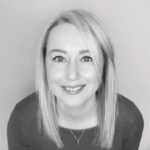
In the image foreground, traditional health professions pre-registration curriculum design meetings often happen in physical spaces, at set times with set agendas. The results are the same types of people contributing in a set way. This is a particular challenge in broader health research where those contributing as curriculum stakeholders, specifically patients with lived healthcare experience, are often white, retired middle-class individuals 1. Therefore, through the processes adopted, the homogenous voices are captured as the voice of everyone.
In this image, crowdsourcing is a digital tool depicted by the “computer” at the top of the ramp 2. Here a diverse group of individuals can join in and have their say on curriculum design at a time and place that works for them. Thus, the heterogeneous characters outside the walls are diverse, representing the broad spectrum of people who ultimately will be cared for by those undertaking health professions educational programmes 3.
References
- Russell, J., Fudge, N., Greenhalgh, T. The impact of public involvement in health research: what are we measuring? Why are we measuring it? Should we stop measuring it? Research, Involvement and Engagement [online]. 2002; 63 (6) [Assessed 10th July 2021]. Available from: https://doi.org/10.1186/s40900-020-00239-w
- Howe, J. What is crowdsourcing? Wired Magazine [online]. 2006. [Accessed 05th April 2021]. Available from: https://sistemas-humano-computacionais.wdfiles.com/local–files/capitulo%3Aredes-sociais/Howe_The_Rise_of_Crowdsourcing.pdf
- John-Matthews, J. Using the ‘wisdom of the crowd’ to innovate in health professions pre-registration curriculum design. DProf thesis, Swansea University; 2022
Author

Dr. Janice St. John-Matthews DProf, MSc. PgC(TLHE), BSc (Hons), SFHEA, FioL.
Janice currently works as Head of Allied Health Professions (AHPs) at NHS England and has been a registered Diagnostic Radiographer for over twenty years. She is also an Associate Editor for the BMJ Leader. AHPs are the third largest clinical workforce in the NHS England representing 195,000 registered staff across 14 professions. As someone who has dyslexia, Janice sometimes struggles to ‘find the right words’ to articulate what she can clearly see in her mind. In these instances, she uses creative approaches to overcome the frustration of ‘seeing’ the answer. This Lego model was built to support her to verbalise her thinking for her Doctorate thesis and the above image was submitted as appendix 24.
Declaration of interests:
I have read and understood the BMJ Group policy on declaration of interests and declare the following interests: None